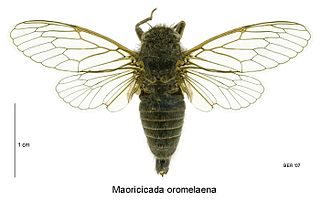
Epyaxa lucidata is a species of moth in the family Geometridae. It is endemic to New Zealand.

Notoreas ischnocyma is a species of moth in the family Geometridae. This species is endemic to New Zealand. This species is found in Canterbury and Otago.

Notoreas perornata is a species of moth in the family Geometridae. It is endemic to New Zealand and is found in the North Island from Northland to Westland as well as in the South Island on the coast of Marlborough.

Kikihia angusta, the tussock cicada, is a species of cicada that is endemic to New Zealand. This species was first described by Francis Walker in 1850.

Kikihia cutora, the snoring cicada, is a species of cicada that is endemic to New Zealand. This species was first described by Francis Walker in 1850.

Kikihia rosea, commonly known as the pink or Murihiku cicada, is a species of insect that is endemic to New Zealand. This species was first described by Francis Walker in 1850.

Kikihia scutellaris, commonly known as lesser bronze cicada, is a species of cicada that is endemic to New Zealand. This species was first described by Francis Walker in 1850.

Maoricicada cassiope, also known as the screaming cicada, is a species of insect that is endemic to New Zealand. This species was first described by George Hudson in 1891. Maoricicada cassiope can be found in mountainous regions of the North and upper South Island.

Maoricicada clamitans, also known as the yodelling cicada, is a species of insect that is endemic to New Zealand. This species was first described by John S. Dugdale and Charles Fleming in 1978.

Maoricicada hamiltoni, also known as the Hamilton's cicada, is a species of insect that is endemic to New Zealand. This species was first described by John Golding Myers in 1926. This species is named in honour of Harold Hamilton.

Maoricicada iolanthe, also known as the Iolanthe cicada, is a species of insect that is endemic to New Zealand. This species was first described by George Vernon Hudson in 1891.

Maoricicada myersi, also known as Myers' cicada, is a species of insect that is endemic to New Zealand. This species was first described by Charles Fleming in 1971.

Maoricicada nigra is a species of cicada that is endemic to New Zealand. This species was first described by John Golding Myers in 1921.

Maoricicada oromelaena, also known as the greater alpine black cicada, is a species of insect that is endemic to New Zealand. This species was first described by John Golding Myers in 1926.

Maoricicada otagoensis is a species of cicada that is endemic to New Zealand. This species was first described by John S. Dugdale and Charles Fleming in 1978.

Maoricicada phaeoptera, also known as the southern dusky cicada, is a species of insect that is endemic to New Zealand. This species was first described by John S. Dugdale and Charles Fleming in 1978.

Maoricicada tenuis, also known as the northern dusky cicada, is a species of insect that is endemic to New Zealand. This species was first described by John S. Dugdale and Charles Fleming in 1978.

Rhodopsalta cruentata, also known as the blood redtail cicada, is a species of insect that is endemic to New Zealand. This species was first described in 1775 by Johann Christian Fabricius and named Tettigonia cruentata.

Rhodopsalta leptomera, also known as the sand dune redtail cicada, is a species of insect that is endemic to New Zealand. This species was first described in 1921 by J. G. Myers and named Melampsalta leptomera.

Rhodopsalta microdora, also known as the little redtail cicada, is a species of insect that is endemic to New Zealand. This species was first described in 1936 by George Vernon Hudson and named Melampsalta microdora.





















